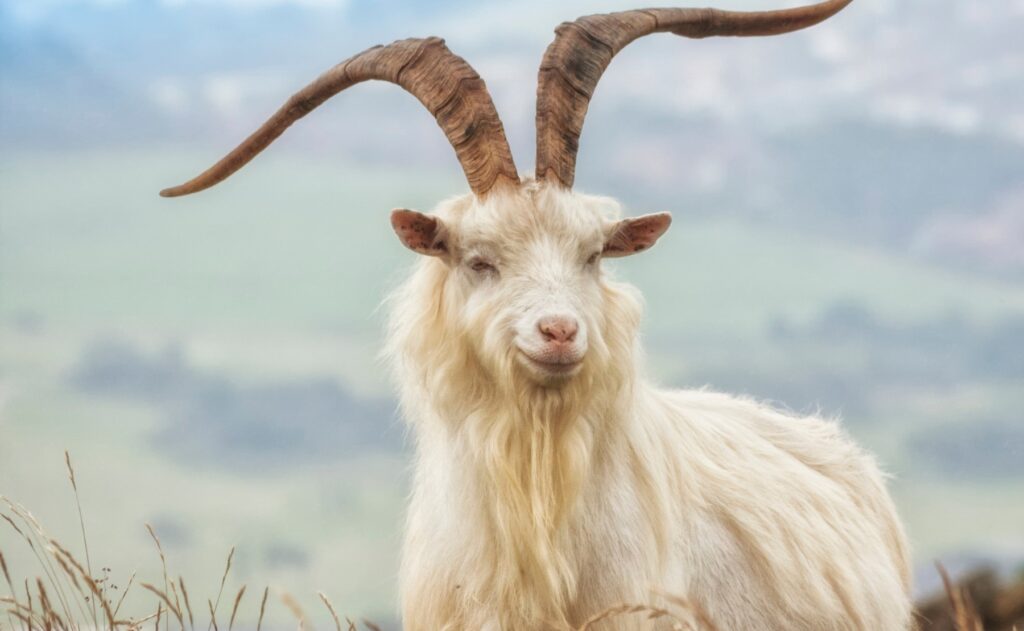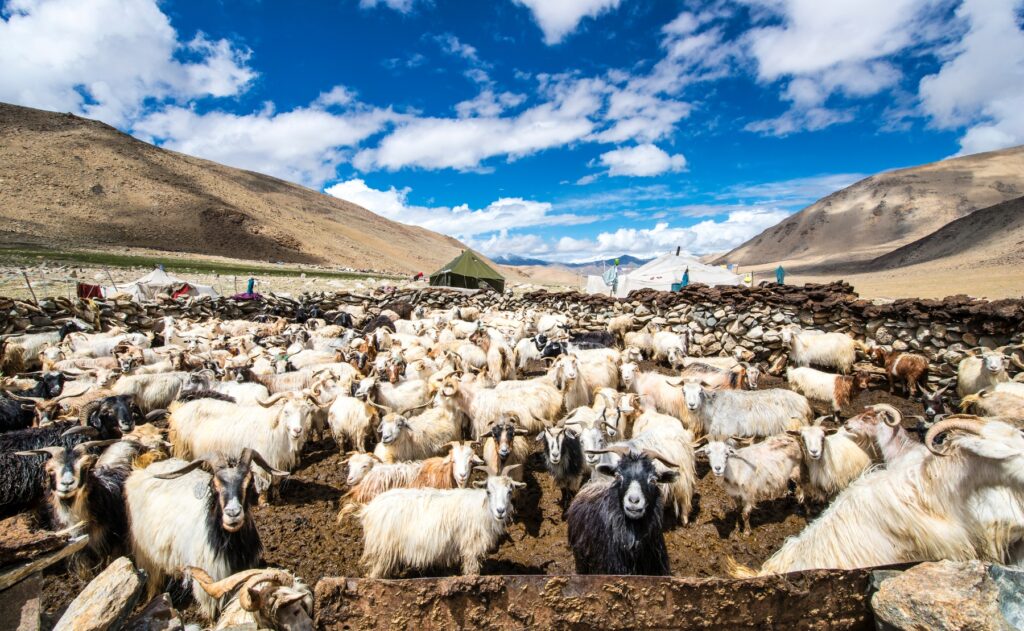Learn all about the desirable traits and features of Hexi Cashmere goats in this comprehensive guide. Explore Hexi Cashmere Goat Characteristics now!
Table of Contents
Introduction
Finding the perfect type of goat for cashmere production can be challenging. Hexi Cashmere goats are exceptional in their wool quality. This article will explore everything you need to know about them.
Keep reading for insights!
Key Takeaways
- Hexi Cashmere goats produce high-quality cashmere wool, which is soft, warm, and highly valued in the fashion industry. These goats grow a luxurious undercoat to protect themselves from cold weather in their native habitats.
- These goats thrive on a specific diet rich in nutrients including high-quality roughage like hay, pasture grasses, and shrubs. Supplemental feed rich in protein and essential minerals supports their health and optimal wool production.
- Hexi Cashmere goats have unique features that make them easily recognizable among other breeds. They adapt well to harsh climates thanks to their strong legs and hooves for navigating rocky terrains.
- Farmers need to provide proper care including regular trimming of hooves, adequate shelter against harsh weather conditions, clean living spaces to prevent disease spread, and consistent healthcare routines for vaccinations and deworming.
- Integrating Hexi Cashmere goats into sustainable farming systems can enhance biodiversity, soil health, and provide farmers with lucrative income streams from the sale of high-quality cashmere wool as well as meat and breeding stock.

Image Source: Canva
Origin, History, and Types of Cashmere Goats
Cashmere goats have a rich history that traces back thousands of years. They are originally from the mountainous regions of Mongolia, Tibet, and Iran where they adapted to harsh climates by developing their dense, soft undercoat known as cashmere.
This valuable fiber has been harvested for centuries, with records indicating its use in garments as early as the 3rd century BC. The trade routes of the Silk Road played a crucial role in introducing cashmere to other parts of Asia and eventually Europe.
There are various types of cashmere goats based on their geographic locations including the Hexi Cashmere goats found in China, Pashmina goats from the Himalayan region of India and Nepal, and others from Mongolia and Iran.
Each type has adapted to its environment not just in terms of physical characteristics but also regarding wool quality which influences its desirability in global markets. Despite these differences, all cashmere goats share common pros such as producing luxurious wool that is highly sought after worldwide for making high-quality fabrics.
Characteristics of Hexi Cashmere Goats
Hexi Cashmere Goats are known for their distinct features, high wool production, and adaptable behavior. Their unique identification markers make them easily recognizable among other goat breeds.
These goats require a specific diet rich in nutrients to maintain their health and ensure optimal wool growth.
Identification and features
Hexi Cashmere goats stand out with their distinctive long, luxurious coats which are the source of their highly prized cashmere wool. These goats have a set of large, expressive eyes and come in various shades, ranging from white to gray and brown.
Their adaptability allows them to thrive in harsh climates, making them a resilient breed.
They possess strong legs and hooves that are well-suited for navigating rocky terrains found in their native habitats. This unique combination of features not only contributes to their survival but also affects the quality and quantity of cashmere they produce.
Moving on, let’s explore how these characteristics influence wool production among Hexi Cashmere Goats.
Wool production
Hexi Cashmere Goats are prized for their high-quality wool, known as cashmere, which is both soft and warm. This luxurious material comes from the fine undercoat these goats produce to protect themselves against cold weather in their native habitats.
Each goat yields a small amount of cashmere wool each year, making it a sought-after commodity. Farmers must comb or shear the goats during the spring to collect this valuable fiber.
The process of turning raw cashmere into wearable items involves several steps including cleaning, sorting, and spinning the fibers. The quality of Hexi Cashmere depends on factors like fiber length, diameter, and color.
These attributes affect the overall feel and durability of finished products. Moving on from wool production opens discussions on another crucial aspect – how these goats behave and why understanding their temperament matters for successful farming.
Behavior and temperament
Hexi Cashmere Goats are known for their hardiness and adaptability, making them well-suited to a variety of climates. These goats are generally docile in temperament, which makes them suitable for handling and management.
They exhibit social behavior and often form strong bonds within the herd. Their curious nature contributes to their active exploration of their surroundings, showing moderate levels of intelligence that aids in problem-solving tasks as well as adapting to new environments.
These characteristics make Hexi Cashmere Goats an ideal choice for farmers looking to raise goats with a calm demeanor while still maintaining alertness and adaptability. The next section will delve into the dietary needs and nutritional requirements essential for these resilient creatures.
Diet and nutrition
Transitioning from understanding the behavior and temperament of Hexi Cashmere goats, it is crucial to delve into their diet and nutrition. These goats thrive on a well-balanced diet consisting of high-quality roughage such as hay, pasture grasses, and shrubs.
Supplemental feed rich in protein and essential minerals plays a vital role in supporting their wool production needs.
Cashmere goats generally require access to fresh water at all times, especially during hot weather or when they are lactating. It’s important for goat farmers to ensure that these animals have access to clean water sources to maintain optimal health and support their overall well-being.

Image Source: Canva
Geographic Distribution of Cashmere Goats Worldwide
Cashmere goats have a global presence, with breeds like the Pashmina goats in the Himalayan region and the Chinese and Mongolian cashmere goats being particularly noteworthy. Each breed thrives in its specific geographical habitat, contributing to the diversity of cashmere goat farming worldwide.
Pashmina goats in the Himalayan region
Pashmina goats thrive in the Himalayan region. These goats adapt well to the harsh climate and rugged terrain, enabling them to produce fine undercoat fibers that are used to create luxurious Pashmina shawls and scarves.
Known for their soft, warm wool, these goats play a significant role in sustaining the traditional handicraft industry in this region.
The Pashmina goats’ ability to survive at high altitudes with scarce vegetation makes them invaluable to local economies, providing livelihood opportunities for herders while preserving cultural traditions.
Chinese and Mongolian cashmere goats
Chinese and Mongolian cashmere goats are renowned for their fine, lustrous wool that is highly prized in the fashion industry. These goats have adapted to survive in harsh climates, developing a thick, downy undercoat that provides exceptional insulation.
Their wool production is impressive, yielding high quantities of sought-after cashmere fibers. In addition to their valuable wool, these goats are well-suited for sustainable farming systems due to their hardy nature and ability to thrive on sparse vegetation.
With proper care and management, Chinese and Mongolian cashmere goats can be an asset to farmers seeking additional income streams from high-value fiber production.
The diet of these goats consists mainly of roughage such as grasses and shrubs found in the arid regions where they originate. Their natural hardiness enables them to withstand the challenging environmental conditions typical of this region.
Integrating Cashmere Goats into Sustainable Farming Systems
Integrating cashmere goats into sustainable farming systems offers numerous advantages for farmers. It enhances biodiversity and soil health while providing a valuable source of high-quality fiber.
Benefits of cashmere goat farming
Cashmere goat farming offers numerous benefits for farmers. The goats’ wool has high commercial value, providing a lucrative income stream. Additionally, they are relatively low-maintenance animals and can thrive in harsh climates, making them suitable for diverse agricultural settings.
Furthermore, their grazing habits help maintain vegetation balance, contributing to sustainable land management practices.
Raising cashmere goats also provides opportunities for diversified income sources through the sale of meat and breeding stock. Their adaptability to various terrains and climates makes them an attractive option for farmers seeking resilient livestock investments.
Best practices for successful goat farming
To ensure successful goat farming, it’s crucial to:
- Provide a nutritious and balanced diet to your goats, including high-quality hay, grains, and access to fresh water.
- Regularly trim hooves and provide proper shelter to protect the goats from harsh weather conditions.
- Keep the goat living space clean and well-maintained to prevent the spread of diseases.
- Implement a consistent vaccination and deworming schedule as part of the herd’s healthcare routine.
- Monitor the health and behavior of each goat closely for early detection of any illness or injury.
- Establish a strong fencing system to secure the grazing areas and protect the goats from predators.
Equipment and housing considerations
Hexi Cashmere goats require adequate equipment and suitable housing for their well-being. Below are essential considerations for setting up equipment and housing for Hexi Cashmere goats:
- Fencing: Construct sturdy fences to contain the goats, preventing them from straying and protecting them from predators.
- Shelter: Provide a shelter with proper ventilation to shield the goats from adverse weather conditions.
- Feeding and Watering Equipment: Install feeders and waterers that are easily accessible for the goats, ensuring their nutritional needs are met.
- Bedding: Use clean, dry bedding materials in the goat’s housing area for comfort and sanitation.
- Milking Equipment (if applicable): If milking the goats, set up a designated area with appropriate milking equipment to maintain hygiene during the process.
- Quarantine Space: Designate an area for isolating sick or new animals to prevent disease spread within the herd.
- Maintenance Tools: Keep essential tools such as hoof trimmers and grooming supplies readily available for regular maintenance tasks.
- Pasture Management: Implement rotational grazing systems to maintain healthy pastures and prevent overgrazing.
- Adequate Space: Ensure proper spacing in the housing area to prevent overcrowding, promote good health, and reducing stress among the animals.
- Security Measures: Incorporate security measures to safeguard the goats from potential theft or unauthorized access to their living space.
Conclusion and Further Resources
Exploring the characteristics of Hexi Cashmere goats has highlighted their unique features, wool production capabilities, and adaptable behavior. These goats provide valuable resources for sustainable farming systems and have a global distribution across various regions.
With proper care and management, integrating cashmere goats into farming operations can yield significant benefits. For further insights on successful goat farming practices and additional resources, explore the diverse opportunities in this ever-evolving realm.
FAQs
What are Hexi Cashmere Goats known for?
Hexi Cashmere Goats are famous for their high-quality cashmere wool, which is soft, warm, and highly valued in the textile industry.
Can you tell me some pros of raising Hexi Cashmere Goats?
One major pro is that these goats produce a luxurious type of wool that can be sold at a high price. They also adapt well to harsh environments, making them easier to raise in various conditions.
Are there any cons to keeping Hexi Cashmere Goats?
Yes, one con is that they require specific diets and management to maintain their health and quality of wool, which can be more demanding compared to other livestock.
How do I know if raising Hexi Cashmere Goats is right for me?
Consider whether you’re ready to invest in their specific care needs and whether you have or can create the right environment for them. Also think about your goals in producing high-quality cashmere wool.